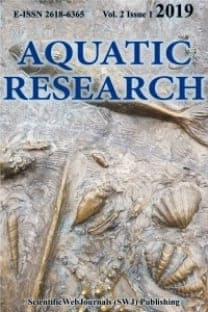BEHAVIOR AND RESPONSE OF JAPANESE CATFISH (Silurus asotus) IN CAPTIVITY PROVIDED WITH AN ARTIFICIAL MICROHABITAT MOSAIC
Rearing of Japanese catfish (Silurus asotus) requires special considerations for designing of facilities and management. Information on its biology in natural environment provides ideas for developing suitable culture systems. For this species, underwater artificial microhabitat structures are needed to perform its normal behavior. The fish shows distinct preferences for some designs based on visual cues and its decision to make use of these structures is guided by other cues probably related to light and water flow. Microhabitat structures can make a real difference to managing stress of captivity in this species. Absence of a suitable structure causes ‘habitat bottleneck’ that develops aggressive behavior. However, the intraspecific antagonistic behavior gives way to social tolerance among conspecifics. Microhabitat metrics is important in addition to physical attributes of the structure so as to allow social grouping in the fish under favorable conditions.
___
Dulmaa, A. (1999). Fish and fisheries in Mongolia. In: Fish and Fisheries at Higher Altitudes: Asia (Petr, T., ed.) pp. 187-236. FAO, Rome.Gaillard, J-M., Hebblewhite, M., Loison, A., Fuller, M., Powell, R., Basille, M., Moorter, B.V. (2010). Habitat–performance relationships: finding the right metric at a given spatial scale. Philosophical Transactions of the Royal Society of London- Biological Science, 27, 2255-2265.
HMC (2015). Stress in Fish: Symptoms and Solutions. The Hartz Mountain Corporation, NJ, USA.
Huckstorf, V. 2012. Silurus asotus. Amur Catfish. The IUCN Red List of Threatened Species Version 2012.2. www.iucnredlist.org IUCN, ISSN 2307 – 8235
Katano, O. Saitoh, K., Koizumi, A. (1988). Scatter-spawning of the catfish, Silurus asotus. Japanese Journal of Ichthyology, 35(2), 203-211.
Kim, I.S., Choi, Y., Lee, C.L., Lee, Y.J., Kim, B.J., Kim, J.H. (2005). Illustrated Book of Korean Fishes. Kyo-Hak Publishing Company, Korea.
Oldfield, R.G. (2011). Aggression and welfare in a common aquarium fish, the Midas cichlid. Journal of Applied Animal Welfare, 14(4), 340-360.
Perterson, M.S., Comyns, B., Rakocinski, C. (2004). Defining the fundamental physiological niche of young estuarine fishes and its relationship to understanding distribution, vital metrics, and optimal nursery conditions. Environmental Biology of Fishes, 71, 143-149.
Shapawi, R., Shaleh, S.R.M. (2015). Biology of aquaculture animals- learning from nature to manage culture, pages 37- 67. In: Aquaculture Ecosystems: Adaptability and Sustainability (Mustafa, S. & Shapawi, R.,eds.), John Wiley, West Sussex, UK.
Sinclair, A.R.E., Fryxell, J., Caughley, G. (eds). (2005). Wildlife Ecology and Management, 2nd edition, Blackwell Science, London, UK.
- ISSN: 2618-6365
- Yayın Aralığı: 4
- Başlangıç: 2018
- Yayıncı: Nuray ERKAN ÖZDEN
